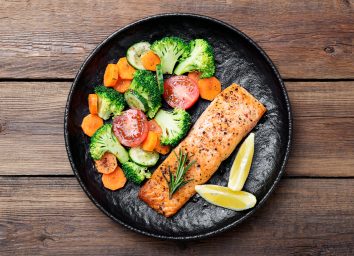Eating Habits You Must Follow If Heart Disease Runs In Your Family

Cardiovascular diseases (CVD), a group of diseases that include conditions that affect the heart or the vascular system such as coronary heart disease, peripheral arterial disease, and even pulmonary embolism, are the most common causes of death worldwide. Over 600,000 people in the United States die from heart disease each year, making it a disease that is important to prevent whenever possible.
One risk factor for developing CVD is having a family history of this disease. Suppose you have at least one blood family member who has CVD or experienced a cardiovascular-related condition like a heart attack, heart failure, stroke, or hypertension. In that case, you have a positive family history of CVD, increasing your own risk of developing this disease.
Thankfully, developing CVD is multi-factorial. Even if you do have a parent or a grandparent who has this disease, there are some dietary habits you can adopt that may help keep your ticker healthy, despite your genetic predisposition.
Read on to learn more, and for more on how to eat healthy, don't miss The #1 Best Supplement If You Have Heart Disease, Says Dietitian.
Add a handful of walnuts to your diet every day.
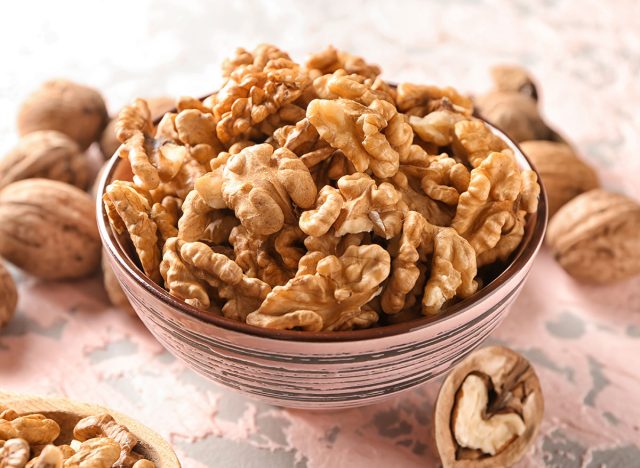
Instead of taking away foods you love from your diet, make it a point to add foods that support heart health. Fortunately for walnut lovers, the simple act of including a serving of walnuts, just one handful (1 ounce) in your diet every day may help support heart health.
Walnuts are the only tree nut that is an excellent source of alpha-linolenic acid (ALA), the plant-based omega-3 essential fatty acid at 2.5 grams per ounce. Research has shown that consuming foods high in omega-3 ALA may help reduce the risk of heart disease through anti-inflammatory effects. Plus, walnuts naturally contain nutrients that may help reduce CVD risk, including magnesium and potassium.
Additionally, a recent study from Harvard found that participants who ate around a handful (five or more 1-ounce servings) of walnuts per week had a lower risk of death and dying from cardiovascular disease. Plus, the participants who ate walnuts gained about 1.3 years on their life, compared to those who reported not eating walnuts.
Adding walnuts to yogurt parfaits, salads, and even grazing boards are easy ways to include more of these powerful nuts in your diet. Or, if you have a sweet tooth, try dipping them in some dark chocolate for some major decadence.
Use olive oil as your fat source.

The fat-free lifestyle craze has seen its way out, and we now understand the importance of including the right kinds of fats in our diet to support our health and wellness.
Olive oil is a source of monounsaturated fatty acids and polyphenols, which are natural plant compounds with antioxidant properties. And recent data published in Clinical Nutrition shows that consuming olive oil is associated with a lower risk of CVD and stroke, with the most benefit observed when people eat between 20 and 30 grams of this oil every (approx. 1.5-2.25 tablespoons per day).
For those who are high-risk, like those with a family history of CVD, every 10 grams of extra-virgin olive oil per day reduced CVD risk by 10%, according to a study published in BMC Medicine.
The obvious way to include more olive oil in your diet is to drizzle it over your veggies, meats, and bread. Less known is that this oil can be used in your baking instead of saturated fat sources like butter and lard. To do this, simply substitute three-quarters of your butter or lard in a recipe with olive oil.
RELATED: Cooking with Olive Oil Decreases Risk of Deadly Diseases, Says New Study
Include fruit in your diet every day.
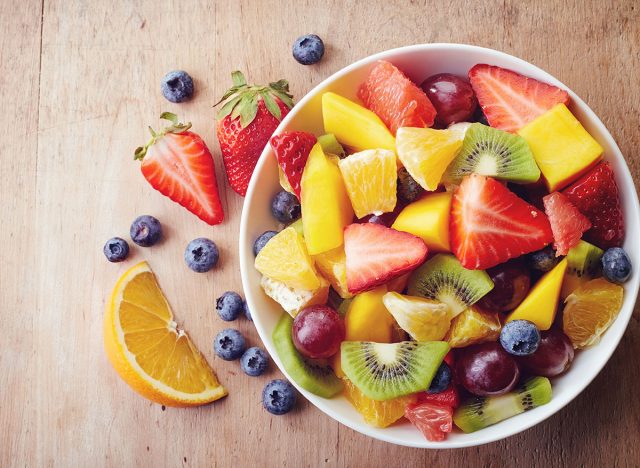
The simple act of eating more fruit may experience a reduced risk of developing CVD, thanks to the vitamins, fiber, minerals, and phytochemicals that they provide.
Unfortunately, only 1 in 10 Americans eats the recommended servings of fruits and veggies each day. But what many people may not realize is that all forms of fruit "count" toward a fruit intake quota, including fresh, juiced, frozen, and freeze-dried, as long as there are no sugars added to it.
For people who don't have access to fresh options all the time, one easy solution for including more fruit in your diet is to lean on dried fruit. Data published in the Journal of the Academy of Nutrition and Dietetics found that people who eat dried fruit regularly had a higher quality diet and were more likely to get enough under-consumed and heart health-supporting nutrients like fiber and potassium than people who didn't include fruit in their diets.
Prunes are one dried fruit linked to positive heart-health outcomes; One study found that postmenopausal women who ate 5-6 of these fruits every day for six months showed improved factors for cardiovascular disease, including increased HDL "good" cholesterol level as well as lowered inflammation.
Sip on green tea.

It may sound surprising that the simple act of sipping on green tea can support your heart health and reduce your CVD risk, but according to results of a meta-analysis evaluating a total of 9 studies, including 259,267 people, those who didn't drink green tea at all had higher risks of CVD compared to those who drank more than 1 cup of the tea every day. More frequent green tea consumption (1-3 cups per week) was linked to a reduced risk of stroke vs. those who drank less than 1 cup every week.
No matter whether it is enjoyed hot or iced, including green tea in your diet is one incredibly easy way to help reduce your CVD risk. Not a tea drinker? Green tea supplements are available and appear to be effective for supporting heart health too.
Use sodium-free herbs and spices instead of salt.
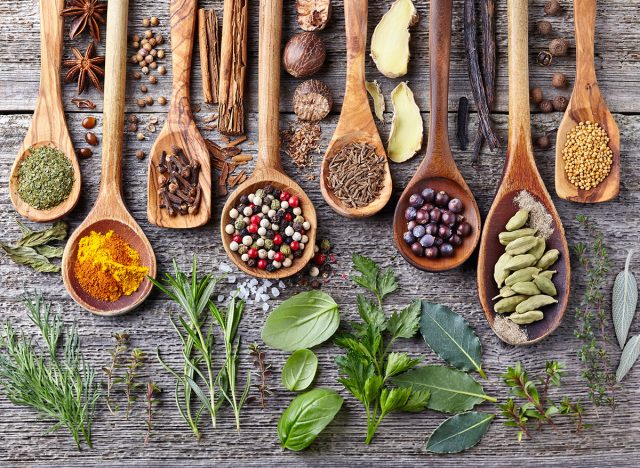
Limiting sodium is one dietary tip linked to reducing CVD risk. The World Health Organization has recommended that people limit their sodium intake to less than 5 grams daily to help support heart health, a goal that many Americans are having a hard time attaining.
Nobody wants to eat bland and flavorless foods. But adding salt to your dishes isn't your only option when you want a little zing in your meal. Instead of reaching for the salt shaker, try adding herbs and spices like garlic, turmeric, basil, and red pepper flakes to your favorite recipes for a sodium-free and surprisingly delicious addition.
Swap out ultra-processed meat with fish, poultry, and nuts.
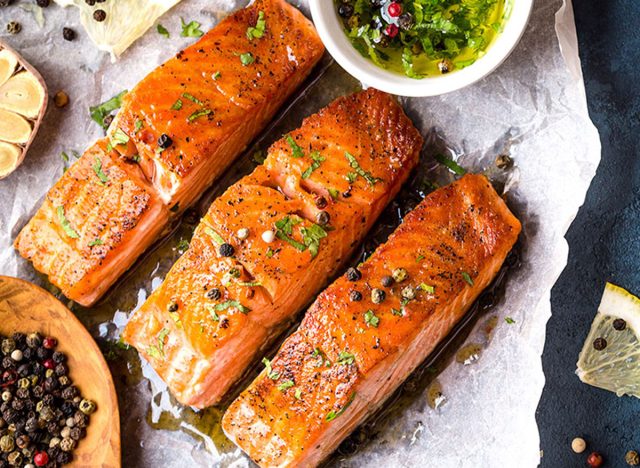
Ultra-processed meats that are cured, smoked, or otherwise preserved have been linked to increased CVD risk thanks to the presence of certain components like sodium, nitrates, and L-carnitine that may lead to elevations in blood pressure, worsening oxidative stress, greater lipid peroxidation, and unfavorable alterations of the gut microbiome.
Replacing processed red meat (like hot dogs and lunchmeats) with other protein sources such as fish, poultry, and nuts was associated with a lower incidence of coronary heart disease, according to data published in Circulation.
Adopt the Mediterranean diet.
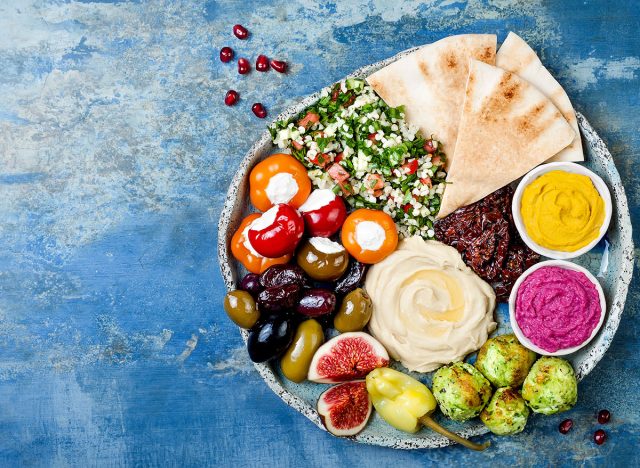
Although the Mediterranean Diet is labeled as a diet, it is really a lifestyle that emphasizes physical activity and eating meals with others. Foods prominent on this diet include items you would expect to see on the plates of people who live by the Mediterranean Sea–olive oil, nuts, seeds, fish, whole grains, fruits, and vegetables. Fried foods, concentrated sweets, and many types of meat are limited on this diet.
Data shows that those who stick to the guidelines of the Mediterranean Diet have better cardiovascular health outcomes, including reductions in rates of coronary heart disease, ischemic stroke, and total cardiovascular disease.



